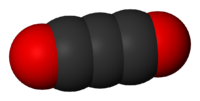Carbon suboxide
 |
|
 |
|
| Names | |
|---|---|
|
IUPAC name
1,2-Propadiene-1,3-dione
|
|
| Identifiers | |
|
3D model (Jmol)
|
|
| ChEBI | |
| ChemSpider | |
| MeSH | Carbon+suboxide |
|
PubChem CID
|
|
|
|
|
|
| Properties | |
| C3O2 | |
| Molar mass | 68.03 g·mol−1 |
| Appearance | colorless gas |
| Odor | strong, pungent odor |
| Density | 0.906 ± 0.06 g cm−3, gas at 298 K |
| Melting point | −111.3 °C (−168.3 °F; 161.8 K) |
| Boiling point | 6.8 °C (44.2 °F; 279.9 K) |
| reacts | |
| Solubility | soluble in 1,4-dioxane, ether, xylene, CS2, tetrahydrofuran |
|
Refractive index (nD)
|
1.4538 (6 °C) |
| 0 D | |
| Structure | |
| rhombic | |
| quasilinear (phase dependent) | |
| Thermochemistry | |
| 66.99 J/mol K | |
|
Std molar
entropy (S |
276.1 J/mol K |
|
Std enthalpy of
formation (ΔfH |
-93.6 kJ/mol |
| Related compounds | |
|
Related oxides
|
carbon dioxide carbon monoxide dicarbon monoxide |
|
Related compounds
|
carbon subsulfide carbon subnitride |
|
Except where otherwise noted, data are given for materials in their standard state (at 25 °C [77 °F], 100 kPa).
|
|
|
|
|
| Infobox references | |
Carbon suboxide, or tricarbon dioxide, is an oxide of carbon with chemical formula C3O2 or O=C=C=C=O. Its four cumulative double bonds make it a cumulene. It is one of the stable members of the series of linear oxocarbons O=Cn=O, which also includes carbon dioxide (CO2) and pentacarbon dioxide (C5O2). Although if carefully purified it can exist at room temperature in the dark without decomposing, it will polymerize under certain conditions.
The substance was discovered in 1873 by Benjamin Brodie by subjecting carbon monoxide to an electric current. He claimed that the product was part of a series of "oxycarbons" with formulas Cx+1Ox, namely C, C2O, C3O2, C4O3, C5O4, ..., and to have identified the last two; however only C3O2 is known. In 1891 Marcellin Berthelot observed that heating pure carbon monoxide at about 550 °C created small amounts of carbon dioxide but no trace of carbon, and assumed that a carbon-rich oxide was created instead, which he named "sub-oxide". He assumed it was the same product obtained by electric discharge and proposed the formula C2O.Otto Diels later stated that the more organic names dicarbonylmethane and dioxallene were also correct.
It is commonly described as an oily liquid or gas at room temperature with an extremely noxious odor.
It is synthesized by warming a dry mixture of phosphorus pentoxide (P4O10) and malonic acid or the esters of malonic acid. Therefore, it can be also considered as the anhydride of malonic anhydride, i.e. the "second anhydride" of malonic acid.
...
Wikipedia
